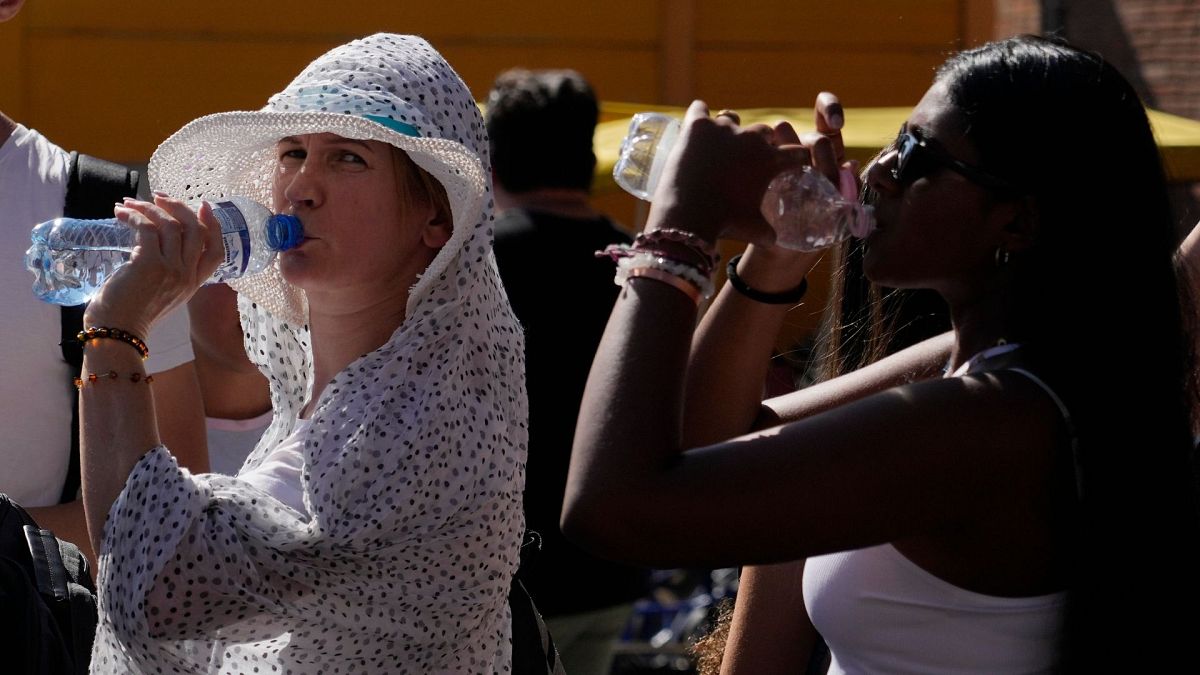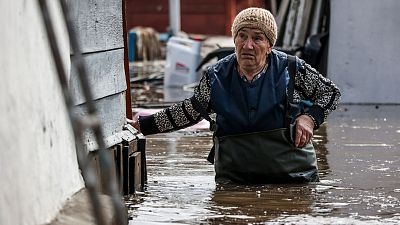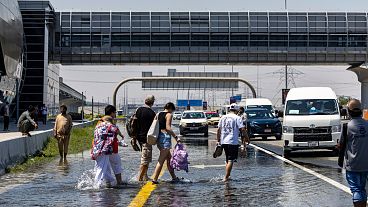2023 was Earth's hottest year on record. With 2024 expected to be even warmer, is Europe prepared for what lays ahead?
2023 has been the hottest year ever recorded.
Data released by the EU’s Copernicus Climate Change Service (C3S) earlier this month revealed that every month from June to November broke global heat records. While December's temperatures are yet to be confirmed, the results are already clear.
On 2 January, the UK's Met Office confirmed that 2023 was the country's second warmest year on record while Northern Ireland saw its hottest yet.
By using physical evidence like polar ice and tree rings to reconstruct temperature records, scientists have also shown that 2023 is likely to be the warmest in 125,000 years.
If greenhouse gases from burning fossil fuels continue to build up in the atmosphere, C3S scientists warn that the temperature will keep rising - along with the risk of deadly heatwaves and droughts.
'I don’t know a single city that is truly prepared'
Many cities susceptible to extreme heatwaves have developed emergency response plans to protect the public.
But experts warn those steps might not be enough in a world that is consistently breaking heat records and deepening inequalities.
“I don’t know a single city that is truly prepared for the worst-case scenario that some climate scientists fear,” says Eric Klinenberg, a professor of social sciences at New York University who wrote a book about a deadly US heatwave.
Heat preparedness has generally improved over the years as forecasting has become more accurate. Meteorologists, journalists and government officials have also started focusing on spreading the word of upcoming danger.
But what works in one city might not be as effective in another.
How is Europe preparing for an ever-hotter future?
Around Europe, cities and countries have adopted measures to alert and protect the public during extreme weather.
France launched a heat watch warning system after an extended heatwave in 2003 was estimated to have caused 15,000 deaths - many of them older people in city apartments and homes without air conditioning.
The system includes public announcements urging people to hydrate. Earlier this year, Germany launched a new campaign against heatwave deaths that it said was inspired by France's experience.
In Paris, fears of a 50°C future have led the French capital to invest in green space. The city's iconic zinc rooftops may need to be replaced with less heat absorbent materials.
Another simple initiative has been floated in Barcelona, Spain: painting rooftops white to reflect the blazing sun.
Buildings themselves are also being impacted by weather extremes. In London, UK for example, prolonged drought and heat are causing historic buildings to crack and tilt, highlighting the need for modernisation that takes extreme temperatures into account.
As temperatures soar, working hours might need to be adjusted to protect employees from deadly temperatures. Spain has already made moves to ban outdoor work during periods of extreme heat.
How do other countries protect citizens against extreme heat?
In India, a powerful heat wave in 2010 with temperatures over 48°C led to the deaths of over 1,300 people in the city of Ahmedabad. City officials now have a heat action plan to improve awareness in the local population and health care staff.
Following a weeklong heat wave that hit 41°C and killed more than 700 people in 1995 in Chicago, the US city developed emergency heat response plans. These include a massive push to alert the public by text and email and then connect the most vulnerable to the help they may need.
Ladd Keith, an assistant professor at the University of Arizona, cites Baltimore’s Code Red Extreme Heat alerts as an example of a well-designed alert system. The alerts go out when the forecast calls for a heat index of 40.5°C or higher, and sets in motion things like more social services in communities most vulnerable to heat risks.
Other US cities like Los Angeles, Miami and Phoenix now have ‘chief heat officers’ to coordinate planning and response for dangerous heat.
But what works in one city might not be as effective in another.
Heatwaves expose cities’ inequalities
Each city has its own unique architecture, transportation, layout and inequities, says Bharat Venkat, an associate professor at UCLA who directs the university's Heat Lab, aimed at tackling what he calls “thermal inequality”.
During Chicago’s deadly heatwave, most of the deaths occurred in poor and majority Black neighbourhoods, where many elderly or isolated people suffered without proper ventilation or air conditioning. Power outages from an overwhelmed grid made it all worse.
Kate Moretti, an emergency room physician in Rhode Island, US, says the city's hospitals see more patients when the heat strikes - with increases in illnesses that may not be obviously related to heat, like heart attacks, kidney failure and mental health problems.
“We definitely notice that it puts a strain on the system,” Moretti said. Older people, people who work outdoors, people with disabilities and people who are homeless make up a big share of those admissions, she says.
Klinenberg says that, in the United States, electrical grids vulnerable to high demand in some regions, along with persistent social inequities, could spell serious trouble in the coming decades.
That's partly because the underlying social problems that make heat events so deadly are only getting worse. Chicago's 1995 deaths were clustered not only in poor and segregated neighbourhoods, but also specifically within what he calls “depleted” neighbourhoods, places where it's harder for people to gather together and where social connections have been worn thin.
Empty lots, abandoned restaurants and poorly maintained parks mean that people are less likely to check up on each other.
Similarly in Europe, people with disabilities have been disproportionately affected by unprecedented heat extremes. This led Human Rights Watch (HRW) last month to urge authorities to provide adequate support on what scientists say is the fastest-warming continent on the planet.
How can heat-related deaths be prevented?
Venkat thinks cities should address inequality by investing in labour rights, sustainable development and more.
That may sound expensive - who pays, for instance, when a city tries to improve conditions for workers in blistering food trucks? - but Venkat thinks doing nothing will ultimately cost more.
“The status quo is actually deeply expensive,” he says. "We just don’t do the maths.”
In the US, Robin Bachin, an associate professor of history and founding director of the Office of Civic and Community Engagement at the University of Miami, notes that the federal government has laws to protect people in cold climates from having their heat shut off in dangerous conditions, but doesn't have something similar for cooling.
“For people in apartments that are not publicly subsidised, there is no requirement for landlords to provide air conditioning,” Bachin says. “That’s incredibly dangerous to particularly our local low-income population, let alone people who are unhoused or are outdoor workers.”
Some cities across Europe have opened public cooling centres - similar to winter’s warm banks.
Street trees and green spaces can also help. Recent research showed that planting more trees in European cities could cut heatwave deaths by more than a third.



